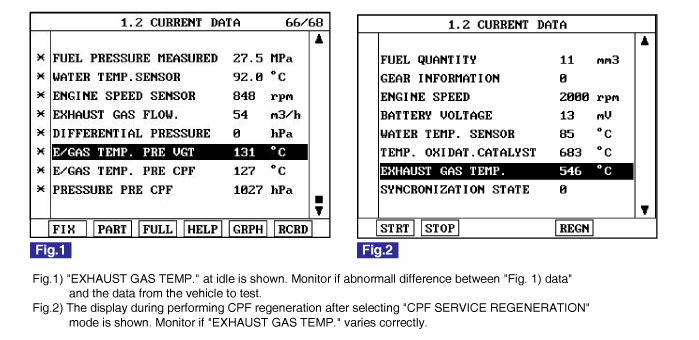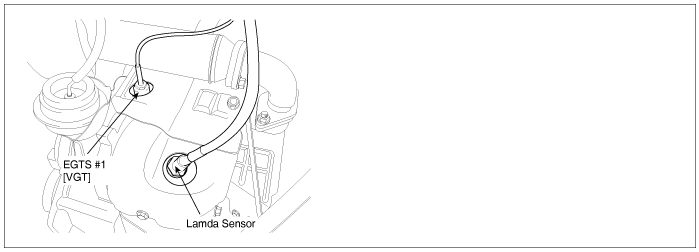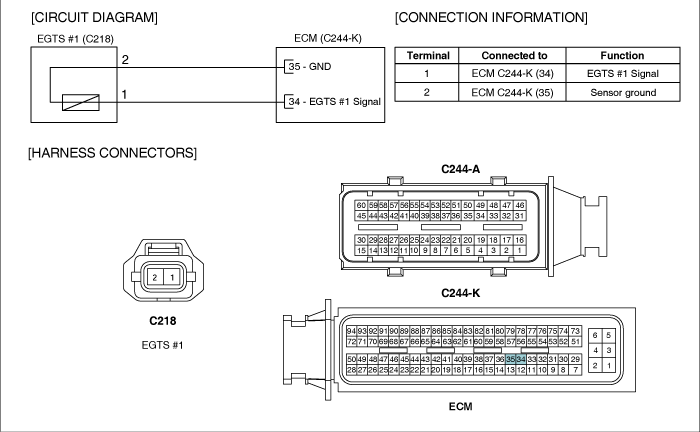Monitor "E/GAS TEMP. PRE VGT","E/GAS TEMP. PRE CPF" parameter on the Scantool.
Specification : Current "E/GAS TEMP." is displayed.


In EURO4 diesel engine with CPF, injection is devided into 2 pilot, 1 main, 2 post injections. Among these injections, pilot and main injections are for the operation of engine, however post injections are for CPF regeneration. Only in activating condition of CPF regeneration during driving, post injection starts. 1st post injection happens at the end of combustion cycle then, injected fuel is used to raise exhaust temperature. that temp. is sensed at T3 exhaust tempt. sensor which is ahead of Turbo charger. 2nd post injection happens at exhaust cycle then, injected fuel is also used to raise exhaust temperature. that temp. is sensed T5 exhaust tempt. sensor which is between Oxydation catalyst and CPF. The reason of raising exhaust tempt. is because exhaust tempt. in diesel engine is too low for CPF regeneration. The optimum tempt. for CPF regeneration is 550~600℃ thus, the goal of post injection is raise exhaust tempt. to that range of tempt.. However if exhaust tempt. is too high, turbo charger or CPF are likely to be damaged. Therefore if tempt. measured at each sensor is out of permittable value(specification), ECM deactivates CPF regeneration.
P1407 is set when the temperature difference between exhaust gas temperature measured by exhaust gas temperature sensor at the front of turbo charger and model temperature memorized in ECM is higher than 200℃ for more than 10sec. This DTC will be turned on in case of the faulty EGTS -VGT itself, circuit malfunction or faulty post injector #1.
Item | Detecting Condition | Possible Cause | ||
DTC Strategy | ● Voltage monitoring | ● Exhaust gas temp. sensor(T3-VGT) wiring ● Exhaust gas temp. sensor(T3-VGT) component | ||
Enable Conditions | ● IG KEY "ON" | |||
Threshold Value | ● | signal temp. - model temp. | is above 200℃. | |||
Diagnostic Time | ● 10 sec. | |||
Fail Safe | Fuel cut | NO | ||
EGR Off | NO | |||
Fuel Limit | NO | |||
Check Lamp | BLINK | |||

Temp. (℃) | Nominal (kΩ) | NEW | AGED | ||
Min(kΩ) | Max(kΩ) | Min(kΩ) | Max(kΩ) | ||
100 | 371 | 289 | 481 | 272 | 515 |
300 | 5.92 | 5.3 | 6.61 | 5.15 | 6.79 |
600 | 0.363 | 0.347 | 0.379 | 0.341 | 0.386 |
900 | 0.0893 | 0.0842 | 0.0949 | 0.0833 | 0.096 |

Connect Scantool to Data Link Connector (DLC).
Warm engine up to normal operating temperature.
Turn "OFF" electrical devices and A/C.
Monitor "E/GAS TEMP. PRE VGT","E/GAS TEMP. PRE CPF" parameter on the Scantool.
Specification : Current "E/GAS TEMP." is displayed.

Electrical systems consist of a lot of harness and connectors, poor connection of terminals can cause various problems and damge of component.
Perform checking procedure as follows.
Check damage of harness and terminals : Check terminals for contact resistance, corrosion and deformation.
Check connecting condition of ECM and component connector : Check terminal seperation, damage of locking device and connecting condition between terminal and wiring.
Disconnect the pin which requires checking at male connector and insert it to the terminal at female connector for checking connecting condition. ( after checking, reconnect the pin at correct position. )
Is the problem found?

▶ Repair the trouble causing part and go to "Verification of Vehicle Repair".

▶ Go to "Signal Circuit Inspection".
Check signal circuit voltage
IG KEY "OFF", ENGINE "OFF"
Disconnect EGTS(T3-VGT) connector.
IG KEY "ON"
Measure the voltage of EGTS(T3-VGT) connector terminal 1.

Specification : 4.8V~5.1V
Is the measured voltage within the specification?

▶ Go to "Ground Circuit Inspection".

▶ Go to "2.Check open in signal circuit" as follows.
Check open in signal circuit
IG KEY "OFF", ENGINE "OFF"
Disconnect EGTS(T3-VGT) connector and ECM connector.
Check continuity between EGTS(T3-VGT) connector terminal 1 and ECM connector(C244-K) terminal 34.

Specification : Continuity ( below 1.0Ω )
Is the measured resistance within the specification?

▶ Go to "Check short to ground in signal circuit".

▶ Repair open in signal circuit and go to "Verification of Vehicle Repair".
Check short to ground in signal circuit
IG KEY "OFF", ENGINE "OFF"
Disconnect EGTS(T3-VGT) connector and ECM connector.
Check continuity between EGTS(T3-VGT) connector terminal 1 and chassis ground.

Specification : Discontinuity ( Infinite Ω )
Is the measured resistance within the specification?

▶ Go to "Ground Circuit Inspection".

▶ Repair short to ground in signal circuit and go to "Verification of Vehicle Repair".
IG KEY "OFF", ENGINE "OFF"
Disconnect EGTS(T3-VGT) connector.
IG KEY "ON"
Measure the voltage of EGTS(T3-VGT) connector terminal 1. [ TEST "A" ]
Measure the voltage between EGTS(T3-VGT) connector terminal 1 and 2. [ TEST "B" ]
( terminal 1 : Check + prove , terminal 2 : Check - prove )

Specification : [TEST "A"] Voltage - [TEST "B"] Voltage = below 200mV
Is the measured voltage within the specification?

▶ Go to "Component Inspection".

▶ When "B" voltage is not detected : Repair open in ground circuit and go to "Verification of Vehicle Repair".
▶ When the voltage difference between "A" and "B" is above 200mV : Eliminate the causes of excessive resistance and go to "Verification of Vehicle Repair".
IG KEY "OFF", ENGINE "OFF".
Disconnect EGTS(T3-VGT) connector.
Measure resistance between EGTS(T3-VGT) terminal 1 and 2, referring to resistance characteristic table of specification of General information.
Specification : Refer to Specification of General Information

Is the measured resistance at certain temperature within the specified resisance range at the temperature?

▶ Go to "Verification of Vehicle Repair".

▶ Replace EGTS(T3-VGT) and go to "Verification of Vehicle Repair".
After a repair, it is essential to verify that the fault is corrected.
After connecting Scantool select "DIAGNOSTIC TROUBLE CODES(DTCs)" mode.
Clear recorded DTC using Scantool.
Drive the vehicle within DTC "Enable conditions" in "General information".
After selecting "DIAGNOSTIC TROUBLE CODES(DTCs)" mode and check if DTC is recorded again.
Are any DTCs recorded ?

▶ Go to the DTC guide of recorded NO. in Scantool.

▶ System operates within specification.